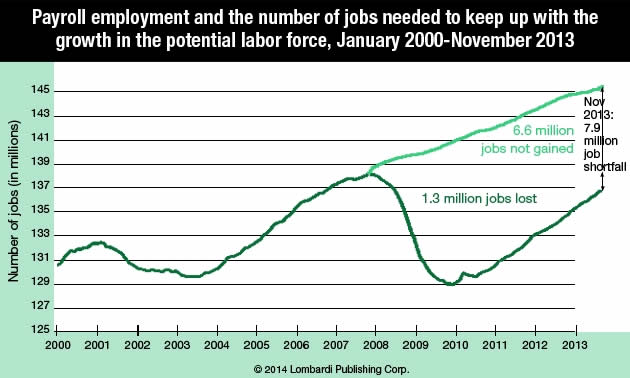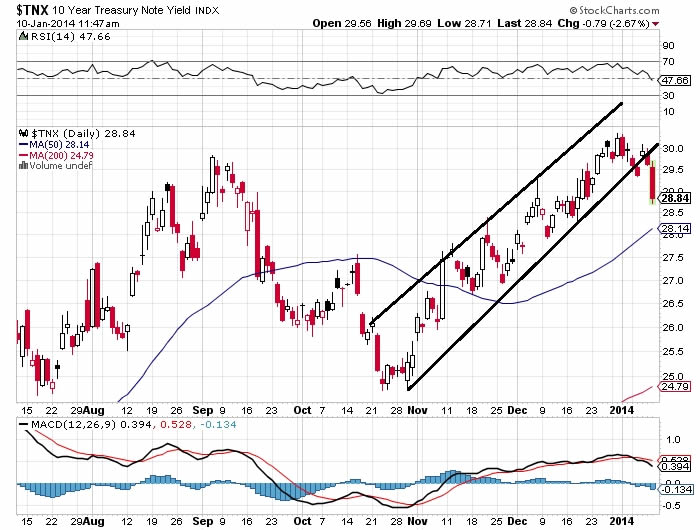Where the Fed Went Wrong When It Decided to Taper QE
Interest-Rates / Quantitative Easing Jan 15, 2014 - 10:29 AM GMTBy: DailyGainsLetter
 John Paul Whitefoot writes: The merriment, mirth, and cheer on Wall Street over the holiday season may have been a bit premature; in fact, the optimism about the U.S. economy that ushered in the New Year may have already come to a screeching halt.
John Paul Whitefoot writes: The merriment, mirth, and cheer on Wall Street over the holiday season may have been a bit premature; in fact, the optimism about the U.S. economy that ushered in the New Year may have already come to a screeching halt.
In mid-December, the Federal Reserve surprised investors when it announced it was going to start tapering it’s generous $85.0-billion-per-month easy money policy in January to just $75.0 billion per month. The pullback was a surprise, because the Federal Reserve initially hinted it wouldn’t ease its monetary policy until the U.S. unemployment rate fell to 6.5% and inflation rose to 2.5%. At the time of the announcement, U.S. unemployment stood at seven percent and inflation was hovering around historic lows below one percent.
The Federal Reserve moved sooner than expected with its tapering because of a (so-called) stronger U.S. economy and jobs growth. And, going forward, it said that U.S. unemployment figures will improve faster than expected. But, a raft of new economic numbers is calling that optimistic forward guidance into question.
In December, the U.S. economy created just 74,000 jobs, the slowest pace in three years, with the majority of the jobs (55,000) coming from the retail industry. Despite the weak jobs growth, the U.S. unemployment rate managed to fall from seven percent to 6.7%—the lowest rate since October 2008. But numbers are deceiving—the big drop in the unemployment rate was primarily a result of 347,000 people dropping out of the labor force.
Throughout 2013, the U.S. economy created 2.18 million jobs; in 2012, the U.S. economy created 2.19 million jobs. Looking at this from another angle, in 2013, the Federal Reserve pumped a trillion dollars into the U.S. economy, sent the stock markets to all-time highs, and helped create fewer jobs year-over-year. Jobs growth is supposed to move in an upward trajectory.
On an even broader scale, the U.S. employment data doesn’t really point to a healthy U.S. unemployment rate. If we take a great leap of faith and suggest the U.S. economy was healthy immediately before the Great Recession began six years ago, then we can extrapolate the data to show that roughly eight million jobs are missing from the U.S. economy. The estimate is based, in part, on how many jobs would have been created to keep up with the labor force growth rate if the U.S. economy was thriving.

Taken altogether, the U.S. unemployment rate may be 6.7% (with the underemployment rate at an unhealthy 13.1%), but that number is misleading, since it’s based, in part, on a large number of people who have dropped out of the workforce or who no longer meet the requirements to be counted as unemployed—not on sustained jobs creation.
So, while the Federal Reserve may have started tapering its quantitative easing strategy because of a so-called “healthy” jobs market, it may have to revisit its strategy and start ramping up its bond buying program again.

Chart courtesy of www.StockCharts.com
Investors have already factored this possibility into 10-year Treasury notes; investors sent the yield on the 10-year Treasury to below its channel support after December’s weak jobs numbers were released.
On the back of ongoing weak jobs numbers, the Federal Reserve will have to rethink its quantitative easing (QE) strategy, which translates into additional bond purchases. Investors interested in purchasing bonds might want to consider a long-term bond exchange-traded fund (ETF), such as Vanguard Long-Term Bond Index ETF (NYSEArca/BLV).
This article Where the Fed Went Wrong When It Decided to Taper was originally published at Daily Gains Letter
© 2014 Copyright Daily Gains Letter - All Rights Reserved
Disclaimer: The above is a matter of opinion provided for general information purposes only and is not intended as investment advice. Information and analysis above are derived from sources and utilising methods believed to be reliable, but we cannot accept responsibility for any losses you may incur as a result of this analysis. Individuals should consult with their personal financial advisors.
© 2005-2022 http://www.MarketOracle.co.uk - The Market Oracle is a FREE Daily Financial Markets Analysis & Forecasting online publication.



